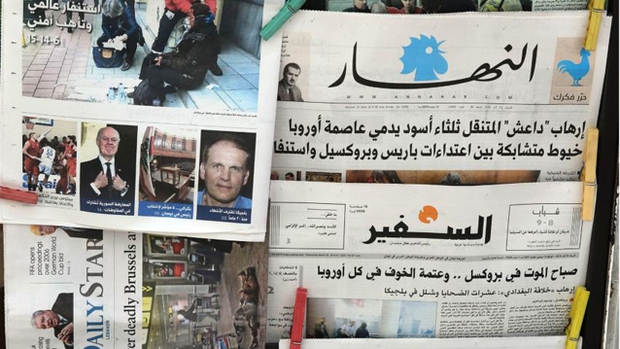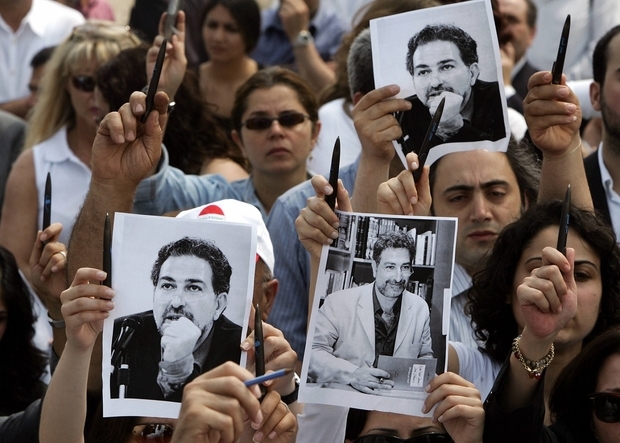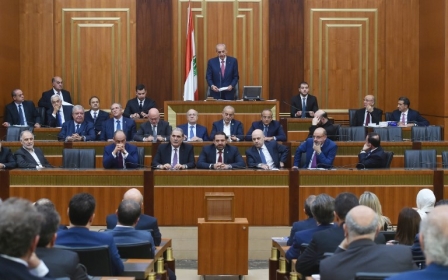Pressing issue: Lebanon's print media is dying
On 11 October, the renowned Lebanese Arabic-language daily An-Nahar created a surprise by publishing an empty eight-page edition. The newspaper aimed to raise the alarm about the press situation in Lebanon.
"An-Nahar's blank pages are a form of expression in relation to the country's catastrophic situation," its director Nayla Tueni said in a news conference.
A few days earlier, Dar Assayyad, one of the country's oldest publishing houses, unexpectedly announced the suspension of all its activities as of 1 October. The group founded in 1943 published al-Anwar, an Arabic-language daily newspaper, and about 10 magazines distributed in Lebanon and Arab countries, including the Gulf states.
An-Nahar's blank pages are a form of expression in relation to the country's catastrophic situation
- An-Nahar director Nayla Tueni
Last June, the major pan-Arab daily al-Hayat, founded in 1946 and acquired by Saudi Prince Khaled bin Sultan bin Abdulaziz in 1996, closed its office in Beirut.
But the most dramatic shock was the disappearance of the prestigious daily newspaper As-Safir on 31 December 2016.
A voice for "Arab causes", the newspaper published throughout its 42 years of existence (1974 to 2016) the most celebrated Arab intellectuals and writers. Its owner and editor, Talal Salman, was considered one of the most influential Arab journalists.
Magazine, the country's first weekly since 1957, became a monthly magazine in October 2016 in an effort to reduce production costs. On 14 October, Lebanon's only French-language daily newspaper, L'Orient-Le Jour, increased its price by 30 percent in an attempt to limit its losses.
Over the past 10 years, nearly 500 journalists and hundreds of other employees in the media industry have found themselves unemployed.
A fall in advertising revenues
The global press crisis and financial difficulties in part explain this phenomenon. The advertising market is the most affected by the economic crisis that has hit Lebanon since the beginning of the war in Syria in 2011.
According to ArabAd magazine and social researcher the Ipsos Institute, the total of Lebanese companies' advertising budgets in 2016 was $174m, a decrease of 8.5 percent compared to the previous year.
Print media only attracted $20m, representing 11.5 percent of these budgets. This amount is derisory given the number of publications - eight daily newspapers in 2016 and about 20 magazines - and the high production costs. Advertising expenditure fell significantly again in 2018.
"What is the benefit of all this diversity in a small country like Lebanon, with a newspaper readership of no more than 250,000 people, only half of whom buy a newspaper," the journalist wrote in a study published on his Facebook page.
According to Saab, "with 120,000 newspapers sold every day, that's only 12,000 sales per day [...], which is not even enough to cover the cost of paper, not to mention salaries".
What is the benefit of all this diversity in a small country like Lebanon, with a newspaper readership of no more than 250,000 people, only half of whom buy a newspaper
- Edmond Saab, journalist
The profusion of newspapers in Lebanon is explained by the fact that for decades, the Lebanese press was aimed not only at local readers, but at the entire Arab readership, including the countries of the Levant, the Gulf and Egypt.
The freedom of speech in Lebanon and the professionalism of the country's journalists meant that Lebanese publications served as forums and platforms for both Arab regimes and their opposition.
"Many newspapers received financing from Arab countries, such as Iraq, the Gulf states, Libya or Syria," Scarlett Haddad, a member of the executive committee of the Lebanese Press Order, told Middle East Eye.
Millions in Arab funds
For decades, tens of millions of dollars from Arab countries have allowed the Lebanese press to prosper, or even live beyond its means, without worrying about building a strong and viable sector.
"Newspapers were spending recklessly. They had extensive networks of correspondents and equipped themselves with the best technologies. In downtown Beirut, An-Nahar has a building worthy of the New York Times," says Haddad.
The Arab states, donors to the Lebanese press, did not only clash with the words written in the columns of newspapers. Lebanese journalists paid a heavy price for the settlement of scores, particularly between Syria and Iraq, countries led in the 1970s and 1980s by two rival branches of the Baath Party.
Riad Taha, a former president of the Press Order and a close friend of Iraq, was murdered in 1978, as was Salim al-Lawzi, editor-in-chief of the famous weekly al-Hawadeth, who was tortured and killed.
More recently, in 2005, the chief executive of an-Nahar, Gebran Tueni, was assassinated, and before him, in June of the same year, Samir Kassir, a journalist for the same newspaper.
Because of the easy money that flowed for decades, journalists have neglected the establishment of well-functioning trade unions capable of defending their rights and providing them with social safety nets, such as pension funds or medical coverage, at the end of their careers.
Newspapers were spending recklessly. They had extensive networks of correspondents and equipped themselves with the best technologies
- Scarlett Haddad, Lebanese Press Order
As a result, journalism is one of the least protected professions in Lebanon, and many of the great feathers that shook thrones and regimes 20, 30 or 40 years ago are now living in indescribable precariousness.
But even during this period of crisis, new titles appeared. Al-Akhbar, a committed daily newspaper close to Hezbollah and its regional allies, was founded in the summer of 2006 in the midst of the Israeli war against Lebanon. This anti-American newspaper has succeeded in retaining a portion of the readership and recovering a portion of as-Safir's audience.
On the other hand al-Ittihad, founded in October 2017, failed to keep up especially since its editorial line was close to that of al-Akhbar. Al-Ittihad disappeared three months after its launch.
The sharp drop in advertising revenues, the end of generous subsidies from the Gulf states, the closure of Arab markets, particularly Iraqi and Libyan, which allowed Lebanese publications to sell tens of thousands of copies, coupled with the appearance of online news sites, are all factors that have contributed to the decline of the press in Lebanon.
But the Lebanese press still has a major asset: freedom of speech, which is lacking in most Arab countries of the Levant, despite some progress, such as in Jordan or Iraq. However the Lebanese press still needs to redefine its vocation.
- The article is an edited translation of a story that was originally published by Middle East Eye's French website.
New MEE newsletter: Jerusalem Dispatch
Sign up to get the latest insights and analysis on Israel-Palestine, alongside Turkey Unpacked and other MEE newsletters
Middle East Eye delivers independent and unrivalled coverage and analysis of the Middle East, North Africa and beyond. To learn more about republishing this content and the associated fees, please fill out this form. More about MEE can be found here.







